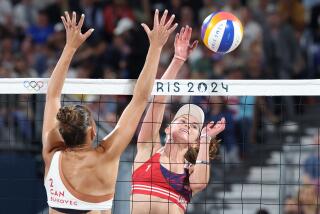For U.S. Men, It’s the June Swoon
- Share via
If this is June, then it must be France--as in the French Open, the first leg of the tennis Grand Slam, where, for the past 30 years, the red clay at Roland Garros Stadium has acted more like quicksand for men from the United States.
It’s a continuing saga. Call it: The Perils of the Young Americans in Paris.
Although Chris Evert Lloyd and Martina Navratilova have fared well here in recent springs, winning five of the past six women’s titles, the men’s division in the French Open has been conspicuously without an American champion since 1955. That’s when Tony Trabert successfully defended his singles title.
As it has developed, Trabert’s victory has proved to be a particularly significant piece of history. Since then, the United States has drawn the collar. A big fat zero. 0 for three decades.
Consider all who have taken up the challenge during that span--John McEnroe, Jimmy Connors, Arthur Ashe, Stan Smith, Vitas Gerulaitis, Roscoe Tanner.
None has walked off the court after a French Open final a winner.
McEnroe and Connors are still trying. But Connors--bothered in 1985 by racket problems, back problems and the assorted sundry problems of turning 32--can no longer be considered a leading threat. And McEnroe, perhaps having more pure skill than any American before him, rates only among a cast of contenders that is headed by Czechoslovakia’s Ivan Lendl and Sweden’s Mats Wilander.
Clay and American tennis players have never been much of a combination. The best proof of that came last December, when what was supposed to be the greatest Davis Cup team ever--led by McEnroe and Connors--got ambushed and embarrassed in the final by Sweden, 4-1.
On clay, of course.
It’s not that Americans, for some intrinsic or inherent reason, cannot play on clay. Steady baseliners, such as Jimmy Arias and Aaron Krickstein, can hold their own on the ultra-slow surface.
It’s more a matter of experience. While Europeans grow up pounding ground strokes on the stuff, Americans encounter clay mainly in their grade school arts-and-crafts class.
The U.S. juniors clay-court circuit has all but died. Only a handful of tournaments remain.
American tennis players learn the sport on concrete, partly by convenience, because court maintenance is easier, and partly by preference. On the hard courts, the game is faster, and isn’t that the way Americans prefer things?
Johan Kriek, a transplanted South African living in Florida, believes so.
“I don’t think the clay-court circuit will survive long,” Kriek says. “I think the French will remain, but the others will fall by the wayside.
“People get bored watching moonballs for five hours and waiting to see who dies. No one wants to watch that.”
Spoken with a true American bias and maybe a touch of sour grapes. For as long as the Swedes, French, West Germans, Italians and Czechs keep breeding new generations of baseliners on clay, there will always be clay tournaments on the professional circuit.
The Americans can either adapt--adding more clay events to their juniors’ calendar--or plan to keep acting like confused tourists every year in Paris.
This year, barring a Big Mac Attack or a monumental upset, the French Open again promises to be a frustrating fortnight for anyone born in the U.S.A.
Add Kriek: Kriek, bidding at 27 to break into the Top 10 for the first time, was an early starter in pro tennis at age 17.
Looking back, he admits to mixed feelings on beginning so young.
“There is good and bad to it,” Kriek said. “If you’re a wonderboy at 15, you can play (professionally) for one year, make $1 million and still go to college.
“But when you’re 14 or 15, and especially in the case of girls, you have a situation where a parent has to quit his job and goes on the tour with the player. It puts too much pressure on the youngster.
“I would not advise anyone to turn pro before 16. I’m sure some would disagree. Look at Nick Bollettieri’s school of world-beaters.
“But all the injuries--these young players with ice on their elbow, their wrist, their knee--aren’t worth it.”
Tennis Notes
Pancho Gonzalez and Whitney Reed head a field of 90 players who will compete in the USTA 40-and-over National Grass Courts Championships in Santa Barbara June 10-17. The tournament, which was won by James Parker of Texas in 1984, will be held at the Montecito Country Club. Admission is free.
More to Read
Go beyond the scoreboard
Get the latest on L.A.'s teams in the daily Sports Report newsletter.
You may occasionally receive promotional content from the Los Angeles Times.










